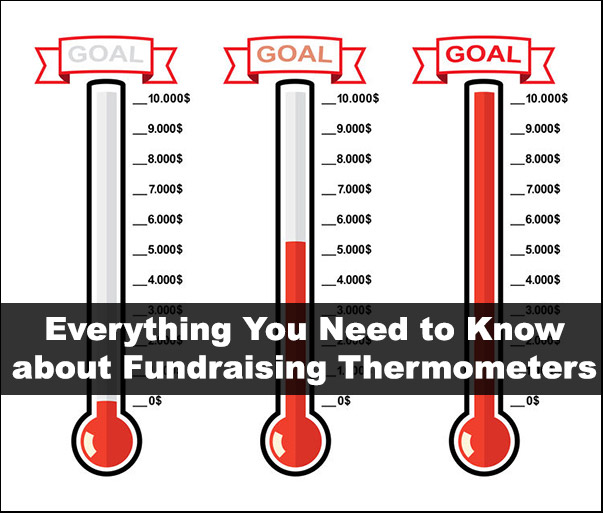Fundraising thermometers are great donation tracking tools that work in real-time at events, on your virtual fundraising page, or internally with your fundraising team.
Here is a quick guide on why they work, how and when to use them, and where to find some free sample templates.

Why Fundraising Thermometers Work
They are visual.
Social media researchers have found that people only retain 10 to 20 percent of what they read online. If the text is paired with a visual, however, the retention goes up to 65 percent. Users have a more favorable response to information with visuals as well, up to 40 percent. We all can deduce that we want our prospective donors to have a favorable opinion of our appeal for funding!
Donors give more when they know how close you are to reaching your target.
This is called the “goal gradient” in helping behavior. People want to see that you are close to reaching your goal because that means that others buy into your cause, and also that their gift will have a big impact in getting you to where you want to go.
This same principle is true for most human activities. We run harder when we are at the end of our time goal. We work harder the last hour of the day to finish a job. It is human nature to want to meet goals, especially when we can see that we are close.
They clearly track fundraising goals and milestones.
A linear representation that is continually updated is appealing because we know exactly where we are in a process. We feel like we are accomplishing things!
How to Use Fundraising Thermometers (Examples)
For specific campaigns:
You should use the thermometer when your campaign is a fixed cost or goal.
- You need a new vehicle and you know how much it will cost and what the impacts will be on meeting your mission.
- You have 3 students in your school who need scholarships and your fund is short.
For specific events:
- You rely on donations at your one big gala event to meet your annual campaign goals.
- You host a golf fundraiser every year and have an annual goal to meet a new record in donations.
- You are hosting a marathon event and want every participant to visually see how their fundraising has helped you meet your mark.
In marketing materials:
- Add them to your giving page. If a donor goes to give a gift, she might give more if she has a visual nudge to understand how giving just a bit more might help you!
- Put them in your newsletters, to show how close you are to your baselines or specific project goals.
- Include them in your email campaigns, especially if you are writing a series of emails for your annual appeal or project appeal and want to show progress.
When to Use Thermometers
In the middle or end of campaigns:
Because of the psychology of the goal gradient, it is best not to kick off a campaign with a blank thermometer. Wait until you have at least half of your donations pledged. You can break your goal into milestones and show progress towards each, alternatively. For capital campaigns, we often break them into “phases” with certain funding goals, for instance. This can help your goals seem more attainable.
When you are relying on volunteers to fundraise with you:
Volunteers and board members will be more encouraged to peer-to-peer fundraise if you give them a specific, visual, percentage of your thermometer to raise. Ask them to pledge to fund a few degrees! This makes them feel like part of a bigger initiative. (See here for more information on peer-to-peer fundraising campaigns.)
When you need something urgently:
Do you need funding for an urgent need? If so thermometers really hit it home that things are “heating up” at your charity, school or nonprofit! In this case, you can even apply a reverse thermometer to show the “hot” urgency of “being in the red”. Donations can turn down the heat and get you back to the optimal body temperature.
What the Thermometer Should Look Like
Thermometers can be horizontal line bars, vertical temperature simulators, static pictures that you change once a week, or running digital tickers of your success. It’s really up to you to pick which one works best for your application!
Here are some samples of promotional tools available on the web, some complete for free.
- Fundraising Thermometer Builder from Fundraising Brick.
- Free Fundraising Thermometer by Sumac.
- Kindful has some “creative” free samples, including a logo thermometer and a logo thermometer.
In conclusion, use thermometers in your campaigns! They are easy to create, with dozens of free tools available. Plus they work.
Fun fact: By the way, do you know who invented the thermometer? Galileo invented a thermoscope in 1593 that could more or less assess temperature. The real inventor of the modern thermometer, however, measuring temperatures accurately to the degree, was Daniel Gabriel Fahrenheit in 1714. Anders Celsius adapted the Fahrenheit scale to the Celsius scale in 1742. We didn’t start using medical thermometers until 1867. Sir Thomas Allbutt, an English Physician, invented one for common use at that time. (See ThoughtCo for more fun thermometer facts!)
